After an extensive five year refit, including altering the complete rig from a ketch to a brigantine schooner and many other changes, we were finally ready for our maiden shake-down cruise on Britannia. It turned out to be more like a shake-up cruise for everyone on board!
We were in a marina in Titusville near Kennedy Space Center, Florida, and planed to travel down the intracoastal waterway, (ICW) that meanders nearly 2000 miles along the whole eastern coast of America. The ICW is ideal for a trial cruise because it is sheltered from the Atlantic Ocean almost all the way by a protective wall of outer banks, many of which have complete towns on them with famous names like Kitty Hawk and Hatteras. From the sea outlet at Fort Worth we then planned to cross the famous Gulf Stream, to the beautiful Bahama islands.
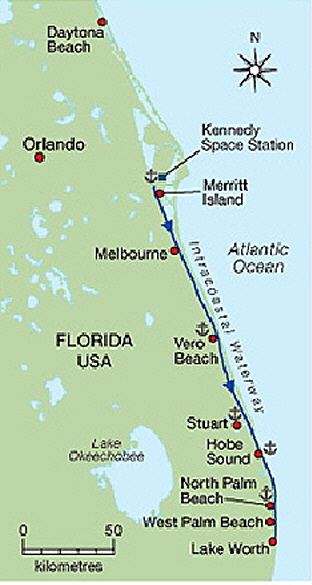 “We” consisted of myself, my wife Kati and my brother Paul, who lives in Australia and had never sailed on Britannia before, or very little else for that matter, The adventure started early for Paul. At our home near Orlando, he decided to grill some steak on our “barbie,” but when he lifted the lid a three foot long snake lay asleep on the grill. I really don't know why he was so taken aback, don't they have snakes on their barbecues in Australia?
“We” consisted of myself, my wife Kati and my brother Paul, who lives in Australia and had never sailed on Britannia before, or very little else for that matter, The adventure started early for Paul. At our home near Orlando, he decided to grill some steak on our “barbie,” but when he lifted the lid a three foot long snake lay asleep on the grill. I really don't know why he was so taken aback, don't they have snakes on their barbecues in Australia?
A few days later we slipped out of our marina berth on what I thought was a perfect day, clear and warm, and motored out into the intracoastal, smack into a shear wall of pea-soup fog! It was so dense I could hardly see the bowsprit and decided to hook the first mooring field buoy we bumped into and wait until it cleared.
Picking up a buoy was new to Paul, who hooked the ring instead of the floating rope. As the boat moved the boat hook was wrenched from his grasp, gashing his finger. Luckily it floated - the pole that is, and his finger remained attached to his hand. We retrieved the boat hook, patched up Paul and put the kettle on.
A quarter of a mile passage is not a very auspicious start in anyone’s log. Was it a portent of things to come?
As any seasoned sailor would expect, the breeze that eventually cleared the fog came from the south, dead on our bow, so we motored 32 miles to our first anchorage at the end of Merritt Island, just north of Melbourne, where Paul comes from - that is the Australian Melbourne. The ability to anchor overnight more or less anywhere in this protected waterway is a great advantage when testing a boats systems.
We decided to dinghy ashore for dinner, so I attached our new Tohatsu four-stroke outboard to the dinghy. This had sat in my garage for eight months, where it was evidently not happy. Now it obstinately refused to start, even after I changed the fuel. We had a barbecue on the boat, and no snake this time.
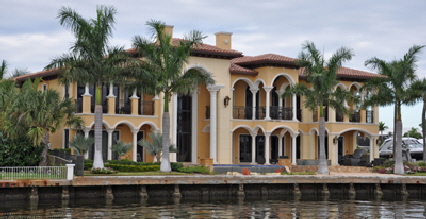 We set off early the next morning with the wind obstinately dead ahead again, but now blowing fifteen knots. The Intracoastal waterway is marked with numbered posts, intermittently spaced depending upon the narrowness of the dredged channel. In places the water is half a mile wide between the outer banks and the mainland, but the actual dredged channel might be only sixty feet wide. I missed a marker on a narrow curve and ran aground for the first time, but not the last. The ground is predominantly soft mud, so after some heavy revs on our good old ‘Perky’ Perkins, 4-236 diesel, Britannia slid slowly off the bank and we motored on.
We set off early the next morning with the wind obstinately dead ahead again, but now blowing fifteen knots. The Intracoastal waterway is marked with numbered posts, intermittently spaced depending upon the narrowness of the dredged channel. In places the water is half a mile wide between the outer banks and the mainland, but the actual dredged channel might be only sixty feet wide. I missed a marker on a narrow curve and ran aground for the first time, but not the last. The ground is predominantly soft mud, so after some heavy revs on our good old ‘Perky’ Perkins, 4-236 diesel, Britannia slid slowly off the bank and we motored on.
There are certainly some fancy houses on sections of this waterway, some with their own sandy beach and deck chairs. Paul spotted one flying an Aussie’ flag and wanted to stop and say “g’day”, until he noticed two big black Rottweiler’s patrolling the beach and eyeing us hungrily.
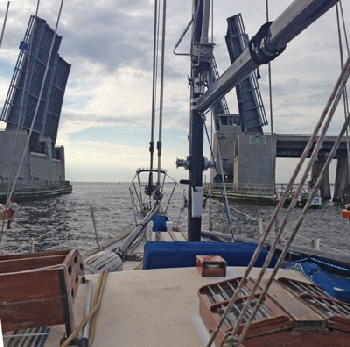 There are of course many bridges spanning the waterway, leading to world famous towns on the outer banks with pristine Atlantic beaches: Daytona Beach: West Palm Beach: Miami Beach, to name but a few. The fixed bridges have clearances not less than 63 feet and Britannia’s main mast is 58 feet above waterline so we could easily pass under them. The older bridges, called bascule bridges, open vertically sometimes at fixed intervals or when you radio the bridge attendant as you approach and they will stop the traffic and open it. It's quite a superior feeling seeing all the traffic halted and having a great big bridge open to your request.
There are of course many bridges spanning the waterway, leading to world famous towns on the outer banks with pristine Atlantic beaches: Daytona Beach: West Palm Beach: Miami Beach, to name but a few. The fixed bridges have clearances not less than 63 feet and Britannia’s main mast is 58 feet above waterline so we could easily pass under them. The older bridges, called bascule bridges, open vertically sometimes at fixed intervals or when you radio the bridge attendant as you approach and they will stop the traffic and open it. It's quite a superior feeling seeing all the traffic halted and having a great big bridge open to your request.
We motored monotonously south into the constant wind, intending to stay the night in the City of Vero Beach Municipal Marina, a distance of only 40 miles, where I planned to take on fuel. We found the narrow marina entrance down the side of a highway bridge crossing the waterway, and quite tricky when the wind is on the beam. I turned on the entrance marker into the channel and we promptly bottomed, whereupon the wind laid us hard on an unmarked submerged bank. This time no amount of engine power would move Britannia because she actually needed to go sideways against the wind. I hailed a passing tiny pontoon boat and asked if they might, “Take my kedge out?” I knew there was no chance of that when the reply came back, “What’s a kedge?” I had no alternative but to lower our dinghy from the davits and hand walk it to the bow, where our smaller anchor, a 35 lbs CQR was lowered into the dinghy with a good coil of line. After a strenuous row into the wind, muttering unprintables at the outboard motor sitting serenely on its perch on the stern, I heaved the anchor over the side and drifted back, exhausted.
I had little doubt our Maxwell windlass would haul the bow against the wind, but only if the anchor held. As the winch ground away and the line drew bar tight the bow slowly started to come off the shoal. Then something remarkable happened: the anchor suddenly reared out of the water like a leaping Dolphin, and the bow fell back in the mud. “That’s the end of that” I thought, (well, not exactly those words), but somehow the anchor re-bedded itself and we finally hauled the head off sufficiently to be able to motor into the deeper channel.
By this time it was dark and I had no idea of the Marina layout. I headed for the first wharf we came to that luckily happened to be the fuel quay. It would have been helpful if there had been a lighted sign on it. As we closed on the wharf Paul heaved the bow line to a person on the dock who promptly pulled it all through the fairlead. He had not tied it to the boat properly and only swift action by Kati with another line prevented us making a complete pigs-ear of it.
I must remember to add a bow thruster on my “things to buy” list...
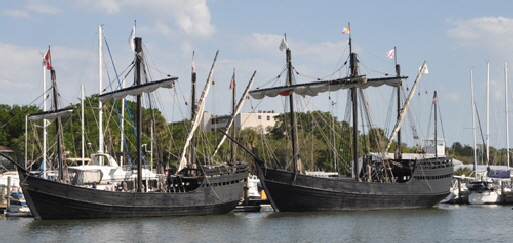 We were then informed, “Oh sure! everybody hits that bank!” which makes you wonder why they don't nail a warning on the entrance post. I will write to the mayor. In the morning we took on 200 gallons of diesel, then changed to one of the marina moorings. The difference being $106 per night in the marina, and only $20 on a buoy. My crew hooked the buoy correctly this time, we were all learning fast.
We were then informed, “Oh sure! everybody hits that bank!” which makes you wonder why they don't nail a warning on the entrance post. I will write to the mayor. In the morning we took on 200 gallons of diesel, then changed to one of the marina moorings. The difference being $106 per night in the marina, and only $20 on a buoy. My crew hooked the buoy correctly this time, we were all learning fast.
During the day replicas of Columbus’ ships Nina and Pinta arrived to great fanfare. These are large ships, drawing much more than my 6’ feet 6” inches, so they must have had a pilot to warn of the entrance shoal.
The following day we motored another 31 miles south into strong head winds to the town of Stuart, where I prepared to anchor clear of the channel.
I snubbed in our 60 Lb CQR bower with about 60’ feet of 3/8” inch chain and the next operation was to shackle the smaller 35 lbs pounder to the same chain to act as a kellett (weight) that I always do for any night anchorage. As I was about to shackle the bridle to the chain a passing motorboat caused a big wake—don’t they always? and the anchor tipped of its roller and vanished into the black water, bridle and all. As Kati heard the “plop” and the accompanying expletives she had the foresight to immediately take a compass bearing. I then quickly dropped our smaller Danforth, this time attached to a rope on the same bearing, hopefully to mark where the anchor had disappeared.
After a few telephone calls Kati managed to locate a diver, who promised to come to our aid at 7 am the next morning. To prepare for ferrying him back and forth I had another go at the intransigent outboard. I cleaned sediment out of the carburetor and jets and after a lot of yanking it spluttered into life.
Promptly at seven the next day we spotted our diver on the shore and I climbed into the dinghy to bring him over. The outboard must have been sulking all night because it adamantly refused to start again, but it did start to rain with a vengeance. I struggled to row to the shore and upon loading the diver, who was half my age, I hoped he might offer to row back but he didn't. Eventually I tied the dinghy to the bobstay and over he went with a great splash, covering me with water that didn't make me any wetter than I already was.
We were only in 12’ feet of water and amazingly he found the Danforth lying right on top of the anchor! The operation only took a few minutes, but had I not marked the spot I think he would never have found the anchor that would have been very costly to replace. The diver asked for $50 but I gave him $60. I was quite proud of this little bit of smart seamanship, especially Kati's foresight, even if it did start with my error. I still gave that anchor a jolly good talking to, I can tell you! As I was about to row the diver back I decided to give the outboard one more yank and behold, it fired, and propelled me swiftly to the shore and back, but it didn't stop the torrential downpour.
In the morning we again chugged southward another 42 miles through a dull drizzle and head wind, reaching Lake Worth without further incident. As we emerged from the protected cut into the large lake proper, we were nearly knocked over by 35 knot gusts and three foot waves from the South East. I had intending to find an anchorage near the outlet to the Atlantic Ocean in readiness to making the 60 mile crossing to the islands, but I knew that everywhere would be very choppy in these winds, so I turned round and laid Britannia on the dock of The North Palm Beach Marina, that we had just passed. After completing paperwork we then moved to a sheltered birth in the marina.
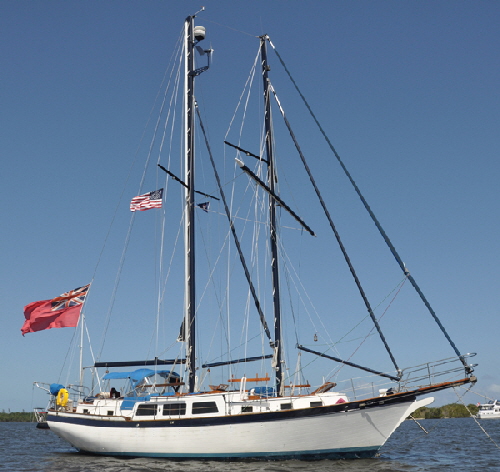 I quickly learned that many other boats were waiting to cross the Gulf Steam. One Beneteau owner had been there a week, but the forecast was “no change” for the following week. Wind, south east 20 to 25 knots, seas in the Gulf Stream six to eight feet and the stream running at up to 3 knots. Kati and I had crossed this stretch of water a few times and we knew it would be very rough, with short steep swells that would toss us about unmercifully, and fighting a 3 knot current at right angles would be an added nuisance.
I quickly learned that many other boats were waiting to cross the Gulf Steam. One Beneteau owner had been there a week, but the forecast was “no change” for the following week. Wind, south east 20 to 25 knots, seas in the Gulf Stream six to eight feet and the stream running at up to 3 knots. Kati and I had crossed this stretch of water a few times and we knew it would be very rough, with short steep swells that would toss us about unmercifully, and fighting a 3 knot current at right angles would be an added nuisance.
Like the other owners, we had to wait for better weather, but at a visitor rate of $100 per night we couldn't stay long, so after a second night we decided to return 28 miles north to the Hobe Sound lagoon anchorage that we had passed on the way down. This was a tight passage in urban surroundings, so even with the wind astern we couldn't sail with safety.
The south easterly was still blowing strong and the anchorage was full of boats. But we were were protected by the barrier island and sat quite comfortably, except for passing moronic power-boaters who have little respect for speed limits and caused so much swell we once bottomed in nine feet of water.
With our now amiable outboard we dinghied to the outer shore and looked at the wild Atlantic that was littered with whitecaps and surfing waves. With my untried boat and rooky crew member I didn't feel confident enough to brave that lot for the crossing to the Bahamas. After three days and still no change in the wind we reluctantly decided to head back north, that would at least be down wind.
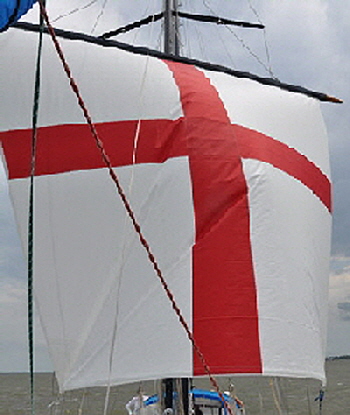 I was determined to test my new squaresail in the following breeze. The first time we entered a section of waterway with relatively deep water either side of the channel I squared the yard to the wind, set up the braces and sheets, then unrolled the 350 sq foot sail from inside it's yard, then mercifully switched off the engine. This was the first time we had actually flown the new sail above a gentle breeze, but after tinkering with the lines we had it pushing hard and Brittania creaming along at seven and eight knots. There are a few terms that are different when you fly a square sail, for example the sail doesn't “pull” like in Bermudian sail terminology, it pushes. There is no better sail for going down wind as the boat remains very stable with no rolling, and no whisker poles and preventers or worrying about gybing. I soon became confident enough to continue through some of the narrower passages and under bridges.
I was determined to test my new squaresail in the following breeze. The first time we entered a section of waterway with relatively deep water either side of the channel I squared the yard to the wind, set up the braces and sheets, then unrolled the 350 sq foot sail from inside it's yard, then mercifully switched off the engine. This was the first time we had actually flown the new sail above a gentle breeze, but after tinkering with the lines we had it pushing hard and Brittania creaming along at seven and eight knots. There are a few terms that are different when you fly a square sail, for example the sail doesn't “pull” like in Bermudian sail terminology, it pushes. There is no better sail for going down wind as the boat remains very stable with no rolling, and no whisker poles and preventers or worrying about gybing. I soon became confident enough to continue through some of the narrower passages and under bridges.
A conventional squares’l billowing out on a 22’ foot long yard would normally need a crew of at least four to scramble up the ratlines and along the yard, to reef or furl the sail. I had no such crew and had therefore devised a system of rolling the sail inside a hollow yard, much like in-mast furling, but horizontal.
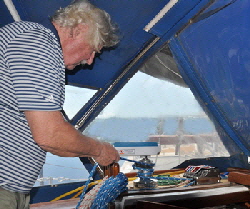 I did became a little anxious as the wind increased to 25 knots, which, adding our forward speed gave a true wind speed of over thirty is force seven, just short to a gale. I didn't want to push our luck with this new sail, so I decided it was time to reef. The sheets were eased, spilling wind as I wound the self-tailing cockpit winch with our electric winch winder and half the sail slowly disappeared inside the yard. It was effortless and worked like a dream. I'm sure LordNelson would have given his other arm to have had this system on Victory.
I did became a little anxious as the wind increased to 25 knots, which, adding our forward speed gave a true wind speed of over thirty is force seven, just short to a gale. I didn't want to push our luck with this new sail, so I decided it was time to reef. The sheets were eased, spilling wind as I wound the self-tailing cockpit winch with our electric winch winder and half the sail slowly disappeared inside the yard. It was effortless and worked like a dream. I'm sure LordNelson would have given his other arm to have had this system on Victory.
We had a magnificent sail north, staying overnight in the same places as we came down, but this time I tied the second anchor to the chain before releasing it.
We also anchored again at the foot of Merritt Island and the outboard continued to co-operate, and we had a nice meal outside at a beach restaurant. As I rose out of my chair I smashed my head on the beach umbrella and nearly passed out. It was all I could do to climb into the dinghy and drive us back to Britannia. I had quite a lump on my head the next morning.
Three days later our marina friends were surprised to see us returning so soon. I told them we would be gone about a month or so, not two weeks. In total we covered the vast distance of 298 miles, half of it against a strong head wind, so there was one thing I was definitely sure of, there isn't much wrong with Perky!
Other things I learned were:
- Always lift the lid of the BBQ before lighting the burners.
- Don't leave an outboard standing for months with fuel in it.
- Make sure everything on the boat works before setting off.
- Don't try to lift a half ton mooring buoy with a boat-hook.
- Always tie a line to an anchor before letting it go overboard.
- Make sure the end of a mooring line is tied to the boat before throwing it ashore.
- Check the weather before setting off.
- Stay tied up in a marina—it’s much easier.
Looking at this list, you wouldn't think I had been sailing for half a century would you? We were disappointed at not being able to make it to the Bahamas, but I was equally sure I made the right decision not to attempt the crossing. Maybe next year.
The adventurous maiden voyage of BRITANNIA and her crew.
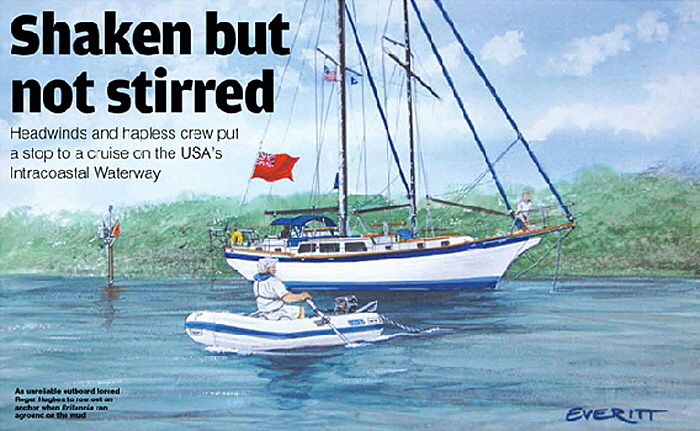
This is a free article which I hope you enjoy.
If you have a project to do, or a repair please support this site by buying an article for only $10.
Thanks ROGER.
THE MAIDEN VOYAGE OF THE GOOD SHIP “BRITANNIA”